Marthinus Johannes de Jongh, known widely as Tinus de Jongh, stands as a significant figure in South African art history. Born in the Netherlands but finding his mature artistic voice under the African sun, De Jongh became one of the most popular and recognizable painters of the South African landscape during the first half of the 20th century. His journey from a decorator in Amsterdam to a celebrated artist in Cape Town is a story of perseverance, adaptation, and a deep connection to the natural beauty he encountered in his adopted homeland. His works, primarily oil paintings and etchings, captured the unique light and topography of the Cape, resonating deeply with both local and international audiences, and securing his place as a beloved visual chronicler of the region.
Early Life and Artistic Awakening in the Netherlands
Tinus de Jongh was born on January 31, 1885, in Amsterdam, the Netherlands. From a young age, he displayed a passion for art, but his path was not straightforward. His parents did not initially support his artistic ambitions, perhaps viewing it as an unstable profession. Bowing to their wishes, he did not pursue formal art training immediately. Instead, he entered the workforce, taking a position at a decorating firm in Amsterdam.
However, the desire to create art burned strongly within him. During his two years working as a decorator, De Jongh dedicated his free time to teaching himself the fundamentals of painting. He honed his skills through observation, practice, and an innate talent. Eventually, his commitment to art became undeniable, and he made the pivotal decision to leave his decorating job and pursue painting full-time.
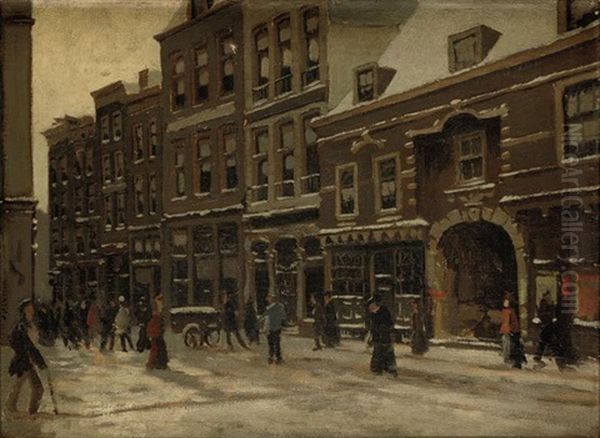
In these early years in the Netherlands, De Jongh's style was naturally rooted in the Dutch artistic tradition. He focused on subjects familiar to his surroundings, creating still lifes and landscapes rendered in the more sombre, tonal palette characteristic of traditional Dutch painting. His talent gained recognition locally; his works began to attract attention, and notably, the prestigious Stedelijk Museum in Amsterdam acquired some of his early pieces. Another mark of his growing reputation was the purchase of his painting, Alkmaar Cheese Market, by the city of Alkmaar itself, signifying a considerable achievement for the self-taught artist.
Emigration and a New Vision in South Africa
The year 1921 marked a profound turning point in Tinus de Jongh's life and art. Seeking new opportunities or perhaps drawn by accounts of the dramatic landscapes of the Cape, he emigrated with his family to South Africa. They settled in Fish Hoek, a coastal town nestled near Cape Town, surrounded by mountains and the sea. This relocation would fundamentally reshape his artistic output.
The move from the often grey, diffused light of the Netherlands to the bright, intense sunlight of the Western Cape had an immediate and transformative effect on his painting style. While his foundational skills remained rooted in his Dutch background, De Jongh quickly realized that his established techniques needed adaptation to capture the unique atmosphere and vibrant colours of his new environment.
He began to move away from the darker palettes of his earlier work, embracing the warmer, more saturated colours demanded by the South African landscape. His brushwork also evolved; he increasingly employed a palette knife alongside brushes, allowing for broader, more textured applications of paint that could better convey the ruggedness of the mountains and the brilliance of the light. This stylistic shift was not merely technical but represented a deep engagement with the spirit of his adopted country.
Capturing the Cape: Subjects and Style
Upon settling in South Africa, Tinus de Jongh found endless inspiration in the landscapes surrounding Cape Town. He became particularly renowned for his depictions of the region's dramatic mountains, rolling vineyards, and, most iconically, the distinctive Cape Dutch farmhouses. These white-walled homesteads, with their characteristic gables, became a recurring and beloved motif in his work, symbolizing a unique architectural heritage set against the timeless backdrop of nature.
His paintings often featured panoramic views, capturing the grandeur of locations like Table Mountain, the Twelve Apostles mountain range, and the picturesque valleys of the Cape Winelands. He possessed a keen eye for atmospheric effects, skillfully rendering the interplay of light and shadow across the mountainsides, the haze of a warm afternoon, or the crisp clarity of the air after rain. His approach was fundamentally realistic, aiming to capture the visual truth of the scene before him.
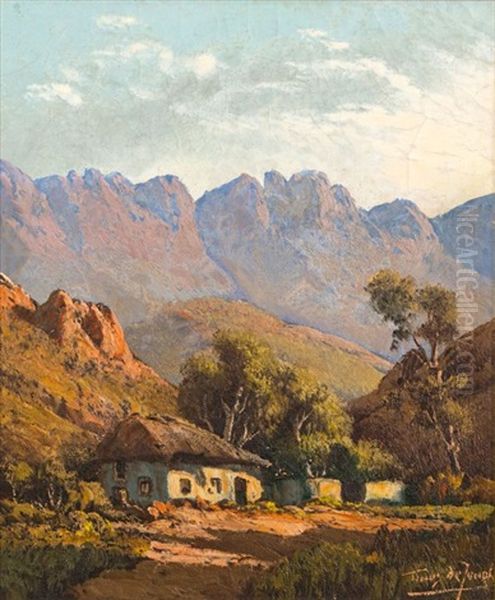
While rooted in realism derived from his Dutch training, his South African work displayed a heightened sense of colour and light. Some observers have noted qualities that might distantly echo Impressionist concerns with light, but De Jongh never fully embraced the broken brushwork or theoretical underpinnings of French Impressionism as seen in the works of artists like Claude Monet or Pierre-Auguste Renoir. His focus remained on the structure and enduring character of the landscape, rendered with a solidity and detail that aligned more closely with Landscape Realism.
Representative Works and Artistic Language
Tinus de Jongh's prolific output includes many paintings that have become cherished representations of the South African landscape. While specific titles varied, certain themes and locations appeared frequently. Works often titled generically, such as Mountain and Cottage or Mountain Landscape, typically depicted the rugged peaks of the Western Cape, often with a solitary farmhouse nestled below, emphasizing the relationship between human settlement and the vastness of nature.
Paintings like Pine Mountain might focus on specific flora within the landscape, showcasing his attention to botanical detail amidst the broader scene. His early Dutch work, exemplified by pieces like Dam Square, Amsterdam, provides a valuable contrast, highlighting the stylistic evolution he underwent after moving to South Africa.
His South African masterpieces include celebrated views such as Clifton and the Twelve Apostles, capturing the dramatic coastal scenery near Cape Town. Cape Landscape is a recurring theme, showcasing his ability to render the expansive vistas and unique light of the region. Works depicting specific locations like Meiring's Poort, a spectacular mountain pass in the Swartberg range, demonstrate his willingness to travel and capture diverse South African topographies. Similarly, Valley Landscape paintings conveyed the serene beauty of the fertile valleys characteristic of the Cape. Through these works, De Jongh developed a distinct artistic language that spoke powerfully of the South African sense of place.
The Prolific Etcher
Beyond his significant achievements in oil painting, Tinus de Jongh was also a skilled and prolific etcher. Recognizing the potential of printmaking to reach a wider audience, he produced a substantial body of work in this medium. He created a notable series comprising approximately eighty different etchings, primarily focused on scenes in and around Cape Town.
These etchings often revisited the same subjects found in his paintings – historic street scenes, views of Table Mountain, charming corners of the city, and rural landscapes featuring Cape Dutch architecture. Rendered with fine detail and tonal subtlety, his etchings captured the essence of his subjects in monochrome.
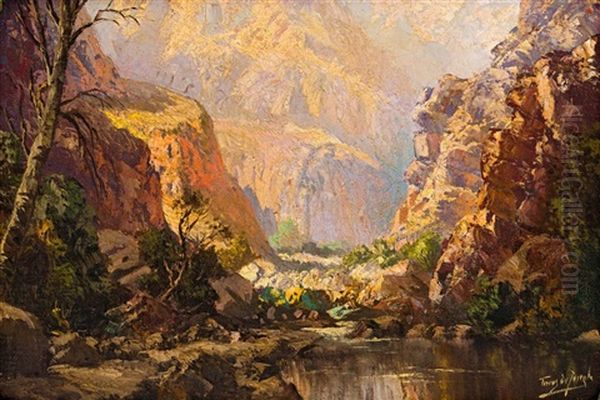
His etchings proved immensely popular. They were distributed and sold through dealers, most notably Louis Woolf(f), who successfully marketed hundreds of these prints both within South Africa and internationally. This aspect of his work significantly broadened his reach and reputation, making his art accessible to collectors who might not have been able to afford an original oil painting. The etchings played a crucial role in cementing Tinus de Jongh's status as a household name in South Africa.
Commercial Success and Widespread Appeal
During his lifetime, Tinus de Jongh achieved a level of commercial success and popular acclaim that few South African artists of his generation could match. His ability to capture the scenic beauty of the Cape in a realistic yet evocative style struck a chord with the public. His paintings were admired for their technical skill, their faithful representation of familiar landmarks, and their often romantic and peaceful atmosphere.
The demand for his work, both oil paintings and etchings, was consistently high. His partnership with dealers like Louis Woolf facilitated the sale of his art across the country and abroad. His depictions of the South African landscape appealed not only to local residents proud of their natural heritage but also to visitors and expatriates who sought mementos of the country's beauty.
This popularity meant that his works entered numerous private collections during his lifetime. While sometimes criticized by modernist art circles for being perhaps too picturesque or commercially oriented, De Jongh's enduring appeal lay precisely in his ability to create images that were both artistically accomplished and deeply resonant with a broad audience, celebrating the landscapes they knew and loved.
Context within South African Art
Tinus de Jongh operated within a vibrant and evolving South African art scene. While his style remained largely consistent with landscape realism, his career unfolded alongside significant developments in South African art. He was a contemporary of several other major figures who were shaping the country's artistic identity.
His focus on landscape places him in dialogue with artists like J. H. Pierneef, who developed a highly stylized and monumental vision of the South African veld, quite distinct from De Jongh's more traditional realism. He also worked during the same period as pioneers of Cape Impressionism, such as Pieter Wenning (another Dutch immigrant) and Hugo Naudé, who explored the effects of South African light with looser brushwork.
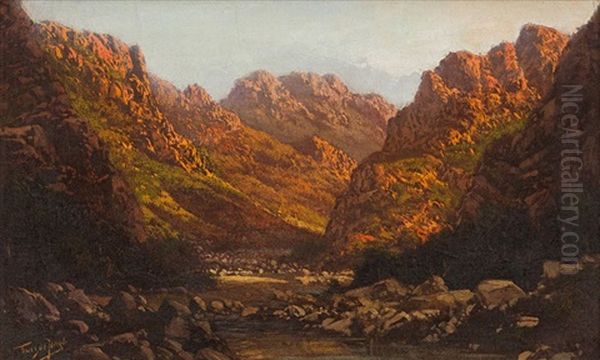
Furthermore, his time overlapped with the rise of South African Expressionism, led by powerful figures like Maggie Laubser and Irma Stern. While De Jongh's work differed greatly in style and intent from their bold, expressive canvases, their concurrent presence highlights the diversity of artistic exploration occurring in South Africa during the early 20th century. Other notable contemporaries included Frans Oerder, another influential Dutch-born painter who spent much of his career in South Africa, and Gwelo Goodman, known for his impressionistic landscapes and cityscapes. De Jongh's unique contribution was his consistent, popular, and highly recognizable realistic portrayal of the Cape landscape.
International Links and Artistic Heritage
Although Tinus de Jongh became intrinsically associated with South African art, his Dutch origins remained a foundational element of his artistic identity. His initial training, though self-directed, was steeped in the traditions of Dutch landscape and still life painting. This heritage is visible in the careful composition, attention to detail, and tonal sensitivity found even in his later South African works.
His realistic approach can be seen as continuing a long lineage of European landscape painting. One might draw distant parallels to the atmospheric realism of 17th-century Dutch masters like Jacob van Ruisdael, or perhaps find echoes of the later Hague School painters such as Anton Mauve, who also focused on realistic depictions of rural life and landscape, albeit in a Dutch context.
The international dimension of his career was further underscored by the sale of his etchings abroad and the inclusion of his work in contexts exploring cross-cultural influences. Exhibitions conceptually similar to the "Transcending Boundaries" theme mentioned in research highlight how artists like De Jongh, who moved between continents, often embodied a fusion of European training and engagement with new, non-European environments. His work serves as an example of how artistic traditions migrate and transform when transplanted to new soil.
Personal Life, Tragedy, and Artistic Legacy
Tinus de Jongh's personal life was marked by both artistic camaraderie and profound personal tragedy. Early in his South African years, he reportedly shared living quarters and creative energy with Jack Pieters, who himself went on to become a successful painter, suggesting a supportive network among artists at the time.
A significant influence on his later life and legacy was his son, Gabriel de Jongh (1913-2004). Gabriel followed in his father's footsteps, becoming a well-known landscape painter in his own right. He learned from Tinus, and initially, his style bore a close resemblance to his father's work. Over time, Gabriel developed his own distinct approach, often characterized by a brighter palette and a more pronounced focus on the interplay of light and colour, particularly in his depictions of clouds and skies.
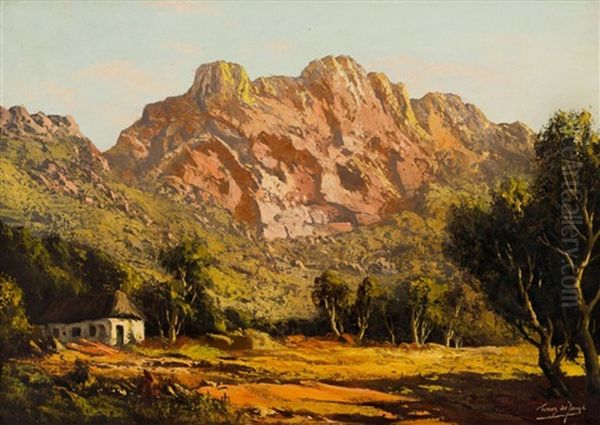
Tragically, the De Jongh family faced immense sorrow in 1942. Gabriel contracted tuberculosis and passed away. This devastating loss deeply affected Tinus. Already battling illness himself, the death of his son seemed to break his spirit. Tinus de Jongh died shortly thereafter, on July 17, 1942, in Bloemfontein, from lung cancer. He was only 57 years old. The close succession of these events suggests the heavy emotional toll Gabriel's death took on him.
Enduring Popularity and Market Value
Despite his passing in 1942, Tinus de Jongh's reputation and the popularity of his work have endured. He remains one of South Africa's most consistently sought-after artists in the secondary market. His paintings and etchings continue to be prized by collectors both in South Africa and internationally.
His works frequently appear at major art auctions, often commanding significant prices. General estimates place his oil paintings anywhere from tens of thousands to hundreds of thousands of South African Rand, depending on size, subject matter, condition, and provenance. Specific auction estimates noted in research, such as £15,000-£20,000 for a Cape Landscape or £30,000-£50,000 for major works like Meiring's Poort or Valley Landscape, attest to his strong standing in the international market for South African art.
His works are held in numerous public and private collections. Museums such as the Ann Bryant Art Gallery in East London, along with other national and regional institutions, preserve his art for public viewing, ensuring his contribution to South African cultural heritage remains accessible. This continued appreciation underscores the timeless appeal of his skillful and heartfelt depictions of the South African landscape.
Conclusion: A Lasting Vision
Marthinus Johannes "Tinus" de Jongh occupies a unique and cherished position in South African art history. As an artist who bridged two worlds – his native Netherlands and his adopted South Africa – he forged a distinctive style that captured the majestic beauty of the Cape landscape with remarkable fidelity and sensitivity. His transition from traditional Dutch techniques to a style infused with the light and colour of Africa demonstrates his adaptability and deep connection to his new surroundings.
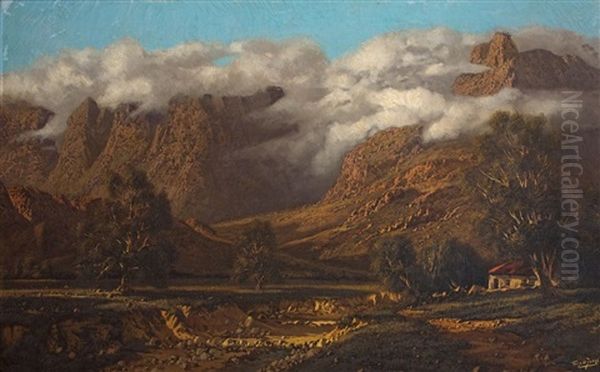
Through his popular oil paintings and widely distributed etchings, De Jongh made the South African landscape accessible and beloved to a broad audience. His depictions of iconic Cape Dutch architecture, dramatic mountain ranges, and serene valleys have become ingrained in the visual identity of the region. While contemporary art movements explored different paths, De Jongh remained committed to a realistic vision that resonated powerfully with the public and continues to do so today. His enduring market presence and representation in public collections confirm his status as a major figure whose work remains a testament to the enduring allure of the South African landscape.